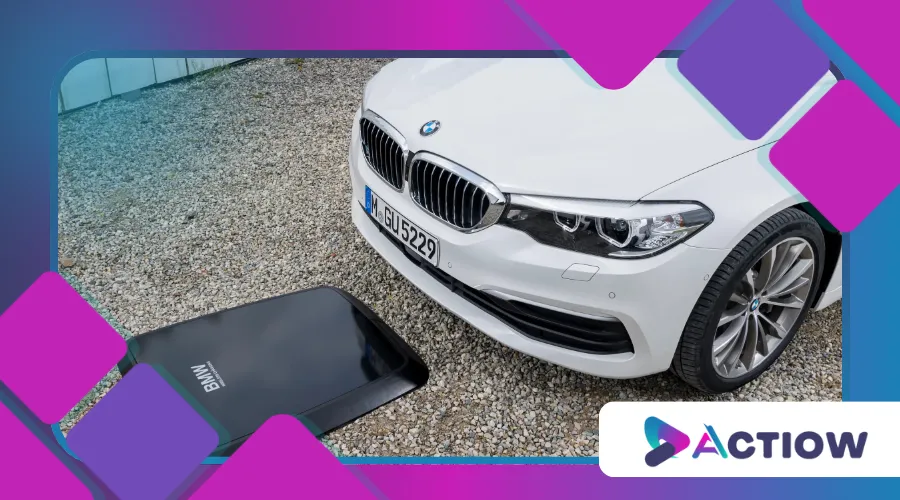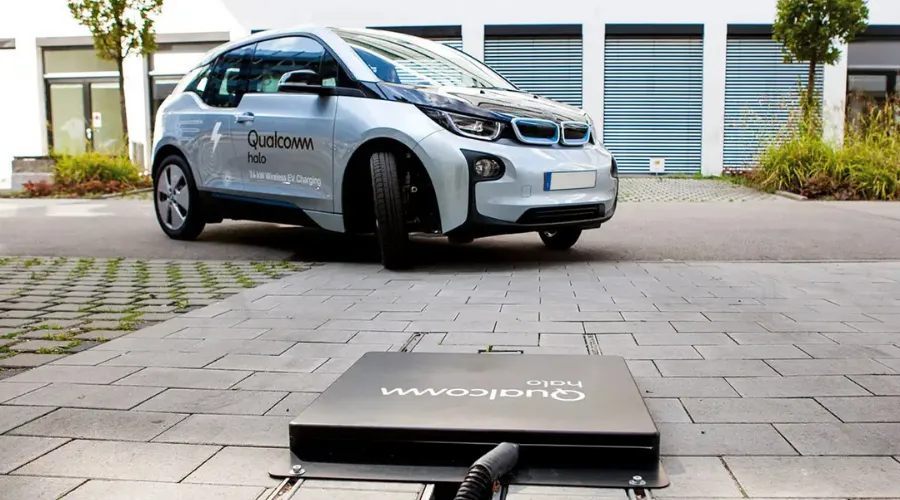Wireless Charging Technology for Electric Cars

Anúncios
Wireless charging technology is quietly reshaping the electric vehicle (EV) landscape, offering a seamless, futuristic solution to one of the most persistent barriers to EV adoption: charging convenience.
Imagine pulling into your garage, parking over a sleek pad embedded in the floor, and walking away as your car juices up without a single cable in sight.
This isn’t sci-fi; it’s the reality being crafted by innovators in the automotive and tech industries.
Anúncios
As EVs surge in popularity—global sales hit 14 million units in 2023, per the International Energy Agency—the demand for smarter, faster, and more user-friendly charging solutions has never been higher.
Yet, the question lingers: can wireless charging technology truly deliver the efficiency and scalability needed to power the EV revolution?
The promise of wireless charging lies in its ability to eliminate the friction of traditional plug-in systems.
No more fumbling with heavy cables in the rain or worrying about frayed connectors.
Instead, this technology uses electromagnetic fields to transfer energy between a charging pad on the ground and a receiver on the vehicle.
It’s akin to the wireless chargers we use for smartphones, but scaled up for the massive energy demands of a car.
This approach not only enhances user experience but also paves the way for a more automated, integrated future where EVs charge effortlessly in parking lots, highways, or even while idling at traffic lights.
The Mechanics Behind the Magic
At its core, wireless charging technology relies on inductive power transfer, a process where an alternating current in the charging pad generates a magnetic field, inducing a current in the vehicle’s receiver coil.
Efficiency is critical here—early systems hovered around 85% energy transfer efficiency, but recent advancements have pushed that figure closer to 93%, rivaling wired chargers.
Companies like WiTricity and Qualcomm are leading the charge, developing systems that can deliver up to 11 kW of power, enough to charge a mid-sized EV in a few hours.
| Charging Method | Efficiency | Power Output | Typical Use Case |
|---|---|---|---|
| Wired (Level 2) | 95-98% | 7-19 kW | Home, public stations |
| Wireless (Static) | 90-93% | 7-11 kW | Home, parking lots |
| Wireless (Dynamic) | 85-90% | 20-50 kW | Highways, urban roads |
The table above highlights how wireless systems are closing the gap with wired alternatives.
Static charging, where the vehicle is parked over a pad, is already practical for home and commercial use.
Dynamic charging, which allows energy transfer while driving, is more experimental but holds transformative potential.
Picture a highway lane embedded with charging coils, keeping your EV powered as you cruise.
Sweden’s “eRoadArlanda” project, for instance, has tested dynamic charging on a 1.2-mile stretch, proving the concept’s feasibility.
Furthermore, as the technology evolves, we can expect improvements in power output and efficiency.
Innovations in materials and engineering will likely enhance the energy transfer process, making it even more effective for everyday use.
Additionally, researchers are exploring the integration of renewable energy sources with wireless charging systems, further promoting sustainability in the EV sector.
Why Convenience is King
Let’s talk user experience, because that’s where wireless charging technology shines brightest.
Plugging in an EV isn’t rocket science, but it’s a chore—especially in harsh weather or cramped urban spaces.
A 2022 survey by J.D. Power found that 68% of EV owners cited “charging hassle” as a top concern.
Wireless systems erase that pain point.
Park, charge, go. It’s that simple.
For businesses, this translates to opportunity.
Imagine a coffee shop offering wireless charging pads in its parking lot, enticing customers to linger while their cars power up.
Or a fleet operator equipping depots with pads to keep delivery vans ready around the clock.
Take Sarah, a fictional San Francisco commuter.
She drives a Tesla Model Y and juggles a hectic schedule.
Her garage has a wireless charging pad installed, synced to her car’s software.
Each night, her EV charges automatically, and her app notifies her of the cost and energy used.
No cables, no hassle.
Now contrast that with Mike, a Chicago-based rideshare driver.
He relies on public fast chargers, often waiting 30 minutes to plug in during peak hours.
A wireless charging hub at his local gas station could save him time and stress, letting him focus on his next fare.
Moreover, the convenience of wireless charging can significantly reduce the barriers to EV adoption for new users.
As more people experience the ease of wireless charging, it may encourage them to transition from traditional vehicles to electric ones.
This shift could lead to a broader acceptance of EVs in society, ultimately benefiting the environment and reducing carbon emissions.

The Road to Scalability
Skeptics argue that wireless charging technology isn’t ready for prime time, citing high installation costs and infrastructure challenges.
They’re not entirely wrong.
Retrofitting parking lots or highways with charging pads requires significant upfront investment—estimates range from $10,000 per pad for home systems to millions for dynamic road networks.
Yet, costs are dropping as production scales.
WiTricity, for example, projects a 30% cost reduction by 2027 as manufacturing ramps up.
Compare that to the $50 billion governments worldwide are already spending on wired charging networks, and the gap narrows.
Scalability also hinges on standardization.
Without universal protocols, a Ford EV might not charge on a BMW-compatible pad.
The Society of Automotive Engineers (SAE) is addressing this, finalizing the J2954 standard in 2024, which ensures interoperability across vehicles and chargers.
This is a game-changer, much like USB-C standardized phone charging.
Once adopted, it’ll spur competition, drive innovation, and lower prices for consumers.
Additionally, public-private partnerships can play a crucial role in accelerating the deployment of wireless charging infrastructure.
By collaborating on funding and resources, stakeholders can help mitigate the financial burden of installation and maintenance.
Furthermore, as consumer demand for EVs continues to rise, the business case for investing in wireless charging technology becomes increasingly compelling.
+ Active Safety Systems: Technologies That Prevent Accidents
Environmental and Social Impacts
Beyond convenience, wireless charging technology could reshape urban planning and environmental outcomes.
Wired chargers clutter streets with cables and stations, often requiring dedicated spaces.
Wireless pads, embedded flush with the ground, are less intrusive, blending into parking lots or sidewalks.
They also reduce wear-and-tear on connectors, cutting down on e-waste.
For rural areas, where wired infrastructure is sparse, portable wireless pads powered by solar grids could democratize EV access.
Socially, the technology could bridge equity gaps.
Low-income communities often lack access to home charging, forcing reliance on expensive public stations.
Municipalities could deploy wireless charging hubs in underserved neighborhoods, offering subsidized rates.
Picture a community center in Detroit with pads available for residents, leveling the playing field for EV ownership.
Moreover, as cities become more congested, wireless charging could help reduce the need for additional charging stations, freeing up valuable real estate.
This efficiency could lead to greener urban environments, where space is utilized more effectively for parks and pedestrian areas.
Additionally, the integration of wireless charging with renewable energy sources can further enhance the sustainability of urban transportation systems.
| Impact Area | Wired Charging | Wireless Charging |
|---|---|---|
| Urban Aesthetics | Visible cables, stations | Hidden pads, minimal footprint |
| Maintenance | Frequent connector replacements | Lower wear, longer lifespan |
| Accessibility | Limited in rural/low-income areas | Flexible deployment, solar integration |

++ Driver Fatigue Monitoring Systems: Technology That Saves Lives
Challenges and Counterarguments
No technology is flawless, and wireless charging technology faces hurdles.
Energy loss during transfer, though minimal, adds up at scale, potentially straining grids.
Critics also point to electromagnetic field (EMF) concerns, though studies, like one from the National Institute of Health in 2023, show EMF levels from EV chargers fall well below safety thresholds.
Then there’s the infrastructure puzzle: dynamic charging requires ripping up roads, a logistical nightmare in congested cities.
But these challenges aren’t insurmountable.
Grid strain can be mitigated with smart charging systems that prioritize off-peak hours.
EMF fears, often overblown, are being addressed through rigorous testing and public education.
As for infrastructure, pilot projects like South Korea’s wireless bus lanes show that phased rollouts are viable.
The real question isn’t whether we can overcome these obstacles—it’s whether we’re bold enough to invest in a future where charging is as effortless as parking.
Furthermore, ongoing research into energy-efficient technologies can help improve the overall efficiency of wireless charging systems.
Innovations in battery technology can also enhance the performance of EVs, ensuring they can take full advantage of wireless charging capabilities.
As the industry evolves, collaboration between automakers, tech developers, and regulatory bodies will be essential to address these challenges collectively.
For more information on the latest advancements in wireless charging technology, check out IEEE Spectrum.
The Autonomous Connection
Here’s where things get exciting: wireless charging technology is a linchpin for autonomous vehicles.
Self-driving EVs need to operate without human intervention, including charging.
A robotaxi can’t plug itself in, but it can park over a pad.
Companies like Tesla and Waymo are already exploring this synergy, with prototypes testing wireless systems for fleet management.
By 2030, BloombergNEF predicts 20% of new EVs will support wireless charging, driven by autonomous demand.
Consider a hypothetical rideshare hub in Los Angeles.
A fleet of autonomous EVs cycles through, each pausing over a charging pad for 15 minutes between rides.
The system optimizes energy flow, reducing downtime and boosting profitability.
This isn’t just convenience—it’s a new business model, where charging becomes invisible, integrated into the fabric of mobility.
Moreover, as autonomous vehicles become more prevalent, the need for efficient charging solutions will increase.
Wireless charging can facilitate the seamless operation of these vehicles, ensuring they remain charged and ready to serve.
Furthermore, the integration of wireless charging with smart city infrastructure can enhance traffic management and reduce congestion, creating more efficient urban environments.
What’s Next?
The road ahead for wireless charging technology is paved with potential, but it demands collaboration.
Automakers, tech firms, and governments must align on standards, incentives, and infrastructure.
Consumers, too, have a role—adopting early systems will drive economies of scale.
If we get this right, we’re not just charging cars; we’re redefining how we move, live, and interact with our cities.
So, what’s stopping us from embracing a world where plugging in feels as outdated as a rotary phone?
The technology is here, the benefits are clear, and the momentum is building.
Wireless charging technology isn’t just a feature—it’s the foundation of a cleaner, smarter, and more connected future.
The only question left is how fast we’ll race to get there.
By staying informed and engaged, we can all contribute to a more sustainable and efficient future of mobility.
